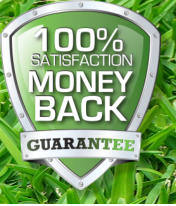



Ultralawn Incorporated
1055 East 260th Street
Euclid, OH 44132
216.731.7756
440.951.3738
Office hours Monday-Friday 9-3 call today with any questions

Brown Patch
Symptoms: The name "brown patch" best describes symptoms of this disease on low-cut turf grasses,
such as golf greens, but the same fungus can cause similar,
though distinct, symptoms in home lawns. Expanding patches
of discolored grass, up to several feet in diameter, mark the
presence of a severe outbreak. The affected turf may turn
brown primarily at the leading edge of the patch while the
grass in the center, though thinned, may remain green.
Diseased areas are sometimes spread out and not so clearly
circular. On individual grass blades, lesions of various sizes
occur which have bleached centers and purplish-brown
borders. Where disease is severe, the affected area may look
sunken. When dew or other moisture is present on the turf
grass, the gray, web-like mycelium of the fungus may be
visible. In rainy weather, or where moisture persists on leaves
because of poor air circulation, abundant white mycelia growth may also be observed.
Season: Brown patch is a disease that thrives during hot, humid weather. It
is most common when night temperatures and relative humidity stay high
for several days and are accompanied by rain. Disease development can be
very rapid under such conditions.
Disease Cycle: In hot, humid weather the fungus becomes active. It grows
well in thatch and soil. The survival structures germinate and produce
grayish to brown mycelium that is capable of infecting the grass blades.
Infection is most severe when the grass is succulent from nitrogen
fertilization and when leaf surfaces remain wet from frequent irrigation or
rain.
Cultural Management: There are two important cultural practices that will
limit brown patch in lawns:
1) Excessive nitrogen applications cause a flush of succulent growth that is
very susceptible to brown patch. Spoon-feeding or several lighter fertilizer
applications are less likely to trigger disease than one heavy application.
2) Water on turf grass leaf blades greatly increases infection and disease. If
the lawn needs moisture, water to a depth of 6 inches early in the day, so
the grass leaves will dry quickly. Do not water in the late afternoon or early
evening. Night watering is not recommended in hot, humid weather. Avoid frequent, light sprinklings.
Brown patch is most severe in creeping bentgrass, perennial ryegrass, and tall fescue lawns. Turf grass
cultivators, that are more resistant or tolerant to brown patch, are available for establishing lawns or
reseeding damaged areas.
Chemical Management: When a lawn has had previous brown patch problems, fungicides may be applied
when humid weather and hot nights are predicted. Applications should continue according to the fungicide
label for as long as the hot, humid weather persists. Fungicides are usually not necessary on Kentucky
bluegrass or fine fescue lawns.

Brown Patch Disease in July

Close up of Brown Patch lesions.


















